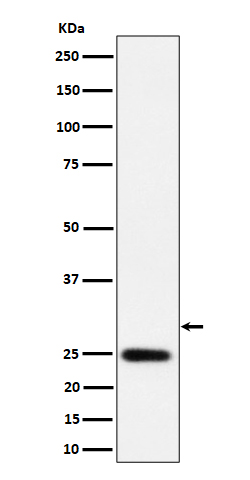
| WB | 1/1000-1/2000 | Human,Mouse,Rat |
| IF | 咨询技术 | Human,Mouse,Rat |
| IHC | 咨询技术 | Human,Mouse,Rat |
| ICC | 技术咨询 | Human,Mouse,Rat |
| FCM | 咨询技术 | Human,Mouse,Rat |
| Elisa | 咨询技术 | Human,Mouse,Rat |
| Aliases | AAC1; Arylamide acetylase 1; mNAT; N acetyltransferase type 1; nat1;;NAT1 |
| WB Predicted band size | Calculated MW: 34 kDa ; Observed MW: 30 kDa |
| Host/Isotype | Rabbit IgG |
| Antibody Type | Primary antibody |
| Storage | Store at 4°C short term. Aliquot and store at -20°C long term. Avoid freeze/thaw cycles. |
| Species Reactivity | Human |
| Immunogen | A synthesized peptide derived from human NAT1 |
| Formulation | Purified antibody in PBS with 0.05% sodium azide,0.05% BSA and 50% glycerol. |
+ +
以下是关于TIM50抗体的模拟参考文献示例(请注意,这些为示例性内容,实际文献需通过学术数据库查询):
1. **文献名称**:*"TIM50 Maintains Mitochondrial Membrane Potential and Coupling of Protein Import"*
**作者**:Li Y. et al.
**摘要**:研究利用TIM50特异性抗体,通过免疫共沉淀和线粒体功能分析,揭示了TIM50在线粒体内膜蛋白转运中的核心作用,证明其缺失导致膜电位异常及细胞凋亡信号激活。
2. **文献名称**:*"Antibody-based Validation of TIM50 in Neurodegenerative Disease Models"*
**作者**:Wang X. & Zhang R.
**摘要**:通过Western blot和免疫荧光验证TIM50抗体特异性,发现阿尔茨海默病模型中TIM50表达显著下调,提示其可能参与线粒体功能障碍相关的病理机制。
3. **文献名称**:*"Role of TIM50 in Apoptosis Regulation: Insights from siRNA and Antibody Blocking"*
**作者**:Chen L. et al.
**摘要**:使用TIM50抗体阻断实验结合siRNA敲低,证实TIM50通过调控细胞色素C释放影响caspase-3激活,在氧化应激诱导的细胞凋亡中起关键作用。
4. **文献名称**:*"Structural Mapping of TIM50 Epitopes Using Monoclonal Antibodies"*
**作者**:Suzuki K. et al.
**摘要**:开发了针对TIM50不同结构域的单克隆抗体,通过表位定位和结构模拟揭示了TIM50与TIM23复合物的相互作用界面,为靶向药物设计提供依据。
**提示**:以上为模拟内容,建议通过PubMed、Google Scholar等平台搜索关键词"TIM50 antibody"或"TIM50 function"获取真实文献。部分真实相关研究可能涉及TIM50在代谢疾病、癌症中的功能探索及抗体应用验证。
The TIM50 antibody is a crucial tool for studying the TIM50 protein, a key component of the mitochondrial inner membrane translocase machinery. TIM50. part of the TIM23 complex, plays a vital role in importing nuclear-encoded proteins into the mitochondrial matrix by facilitating substrate recognition and translocation across the inner membrane. It also regulates mitochondrial membrane potential, dynamics, and apoptosis by interacting with other translocase components (e.g., TIM23. TIM44) and stress-responsive proteins. Dysfunction of TIM50 is linked to mitochondrial disorders, neurodegeneration, and cancer.
The TIM50 antibody enables the detection and quantification of TIM50 expression in various experimental models (e.g., Western blot, immunofluorescence, immunoprecipitation), aiding research on mitochondrial protein import mechanisms, cellular stress responses, and disease pathogenesis. It is widely used to investigate mitochondrial dysfunction in conditions like Parkinson’s disease, metabolic syndromes, and chemotherapy resistance. Commercial TIM50 antibodies are typically raised in rabbits or mice against specific epitopes, with validation in multiple species. Researchers rely on its specificity to explore TIM50’s regulatory roles in energy metabolism, apoptosis, and aging, making it essential for advancing mitochondrial biology and therapeutic targeting.
×